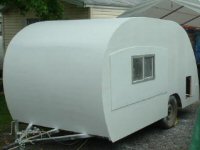weight-saving techniques
73 posts
• Page 2 of 5 • 1, 2, 3, 4, 5
A friend of mine has built several commercial fishing boats out of Airex foam and glass/polyester. One of his boats has been around over 30 years and is going strong. Although a little wood is used here and there (for engine stringers for example which take a lot of vibration from the diesel engines) there is little to no wood used in the construction of the decks and superstructures (he doesn't build the hulls and they are solid glass/polyester).
He does put more mat, roving, and glass on the decks than youse guys are talking about but his boats are holding up under some pretty rough service and doing well. There is no doubt in that a lightweight and durable tear can be constructed out of foam/glass. Maybe just a bit more material in the outside skin than is currently being discussed.
His web site is www.sbmar.com. No pics of the foam construction underway though. His boats look "factory" when he's done but they are all "hand made" foam glass construction with no molds being used.
Cheers,
Gus
He does put more mat, roving, and glass on the decks than youse guys are talking about but his boats are holding up under some pretty rough service and doing well. There is no doubt in that a lightweight and durable tear can be constructed out of foam/glass. Maybe just a bit more material in the outside skin than is currently being discussed.
His web site is www.sbmar.com. No pics of the foam construction underway though. His boats look "factory" when he's done but they are all "hand made" foam glass construction with no molds being used.
Cheers,
Gus
The opinions in this post are my own. My comments are directed to those that might like an alternative approach to those already espoused.There is the right way,the wrong way,the USMC way, your way, my way, and the highway.
"I'm impatient with stupidity. My people have learned to live without it." Klaatu-"The Day the Earth Stood Still"
"You can't handle the truth!"-Jack Nicholson "A Few Good Men"
"Some people spend an entire lifetime wondering if they made a difference in the world. The Marines don't have that problem"-Ronald Reagan
"I'm impatient with stupidity. My people have learned to live without it." Klaatu-"The Day the Earth Stood Still"
"You can't handle the truth!"-Jack Nicholson "A Few Good Men"
"Some people spend an entire lifetime wondering if they made a difference in the world. The Marines don't have that problem"-Ronald Reagan
-

eamarquardt - Silver Donating Member
- Posts: 3179
- Images: 150
- Joined: Sat Nov 11, 2006 11:00 pm
- Location: Simi Valley, State of Euphoria (Ca)
I want it to work for you and doing prototypes they all want it as cheep as they can get I under stand that . when I start at 12 I sweep up just to get there scraps turn the drums on there sides to get the last of the resin tell I could do my first t bucket mold and 1 for the off road bug and hire a sell man no one want to do business with a kid and never look back the last 10 years over 60% has been doing prototypes aircraft work
We have done work for the courts and you think work with a engineer is a pain get 4 are 5 lawyers try to have it there way
When you add layers after it curs it not as strong. It 2 to 3 times more resin to add the ext-er layers and you will fight air
your post are quite impressive and there some that will take it as fact and can louse money fast
look at the guy on e-bay saying his bath tub walls will last
You did a great thing show the web site that show NO they wont't.
now this will cost me a job they want a real fiberglass tear to look like the home dep one for shows I told them no Maybe I will go to court when they get sued
We have done work for the courts and you think work with a engineer is a pain get 4 are 5 lawyers try to have it there way
When you add layers after it curs it not as strong. It 2 to 3 times more resin to add the ext-er layers and you will fight air
your post are quite impressive and there some that will take it as fact and can louse money fast
look at the guy on e-bay saying his bath tub walls will last
You did a great thing show the web site that show NO they wont't.
now this will cost me a job they want a real fiberglass tear to look like the home dep one for shows I told them no Maybe I will go to court when they get sued
It is not the return ON my investment that I am concerned about; it is the return OF my investment
-

glassice - Silver Donating Member
- Posts: 588
- Joined: Fri Sep 22, 2006 1:23 am
- Location: E nev

